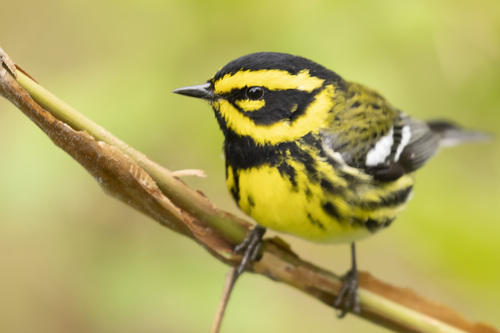
Townsend's Warbler
The Townsend's Warbler (*Setophaga townsendi*) is a small, vibrant songbird known for its striking black and yellow plumage and active foraging behavior. It plays a crucial role in controlling insect populations within its forest habitats. This species is of particular interest to ornithologists due to its hybridization with the closely related Black-throated Green Warbler and Hermit Warbler, offering insights into speciation and evolutionary processes. While not holding major cultural significance, its beauty and energetic presence make it a favorite among birdwatchers.
11-13 cm
Length
18-20 cm
Wingspan
Least Concern
Conservation Status
Distribution
Breeds in coniferous forests of northwestern North America, from Alaska and Yukon south through British Columbia, Washington, Oregon, and into parts of Idaho and Montana. Migrates to wintering grounds along the Pacific Coast from southern California to southern Mexico, and in montane forests of southern Mexico and Central America as far south as Costa Rica. It has a relatively narrow altitudinal range, tied to specific forest types.
Lifespan
Up to 7 years recorded, but average lifespan in the wild is likely shorter (2-4 years).
Townsend's Warbler's Habitat
Habitat Types
Coniferous forests, Mixed coniferous-deciduous forests, Montane forests (wintering grounds)
Climate Zones
Temperate, Subarctic (breeding), Subtropical (wintering)
Adaptations
Their preference for dense coniferous foliage provides camouflage and abundant insect prey. Their migratory behavior allows them to exploit seasonally available resources.
Variations
While no subspecies are formally recognized, there is some variation in plumage brightness and song across its range. Hybridization with Hermit Warblers occurs in a narrow zone in the Pacific Northwest, and with Black-throated Green Warblers in a limited area of Alberta and British Columbia.
Appearance
Breeding Plumage
Males in breeding plumage have a black throat, crown, and ear patch, bright yellow face and breast with black streaks on the sides, and olive-green back. Females and non-breeding males are duller, with a less defined black throat and often a yellowish or olive crown.
Seasonal Feather Changes
Plumage becomes slightly duller in the non-breeding season, particularly in males.
Sex Based Plumage Differences
Significant. Males are much more brightly colored and boldly patterned than females, especially during the breeding season.
Notable Features
Bold black and yellow face pattern (males), Olive-green back, White wing bars
Diet and Feeding
Primary Foods
Insects, Spiders, Caterpillars, Beetles, Occasionally berries and nectar (especially during migration and winter)
Foraging Behavior
Actively gleans insects from foliage and branches in the middle to upper levels of trees. Often hangs upside down to reach prey. May also hover briefly to catch insects.
Specializations
Their slender bill is well-suited for picking insects from leaves and crevices.
Seasonal Diet Variations
Diet shifts to include more berries and nectar during migration and in winter when insect availability is reduced.
Behavior
Social Structure
Generally solitary or in pairs during the breeding season. May form small flocks during migration and on wintering grounds, sometimes joining mixed-species foraging flocks.
Communication
High-pitched, buzzy songs (two main song types: accented and unaccented), Sharp 'chip' calls, Wing flicks and tail movements
Migration
Long-distance migrant. Travels along the Pacific Flyway. Migrates at night. Timing is influenced by photoperiod and weather conditions.
Territorial or Group Behaviors
Males are highly territorial during the breeding season, defending their territory through song and aggressive displays. On wintering grounds, they may defend feeding territories, especially around flowering trees.
Conservation
Threats
Habitat loss and degradation (logging, deforestation), Climate change (shifting habitat suitability, altered insect emergence patterns), Pesticide use (reducing insect prey), Collisions with buildings during migration
Protection Programs
Monitoring programs (e.g., Breeding Bird Survey), Habitat conservation initiatives in breeding and wintering areas, Efforts to reduce pesticide use in forestry
Local National Laws
Protected under the Migratory Bird Treaty Act in the United States and Canada.
Population Trend
Stable
Population Estimates
Global population estimated at 16 million individuals.
Interesting Facts
Hybridization with Hermit Warblers
Townsend's Warblers hybridize with Hermit Warblers where their ranges overlap, with the hybrid zone gradually moving south and east, suggesting Townsend's Warblers are competitively displacing Hermit Warblers.
High-altitude wintering
Some populations winter at high elevations in the mountains of Mexico and Central America, utilizing unique habitats.
Song variation
Males have two distinct song types, one with an accented ending and one without, which may play a role in territorial defense and mate attraction.
Competitively dominant
It is generally dominant over other warbler species at rich food sources, such as flowering trees, during migration and on the wintering grounds.
Faqs about Townsend's Warbler
What is the difference between a Townsend's Warbler and a Hermit Warbler?
Townsend's Warblers have a black throat and ear patch, while Hermit Warblers have a yellow face and black chin. Hybrids show intermediate characteristics.
Where can I see a Townsend's Warbler?
During the breeding season, look for them in coniferous forests of northwestern North America. During migration and winter, they can be found along the Pacific Coast and in montane forests of Mexico and Central America.
What do Townsend's Warblers eat?
Primarily insects and spiders, but they also eat berries and nectar, especially during migration and winter.
Are Townsend's Warblers endangered?
No, they are currently listed as Least Concern by the IUCN, with a stable population trend.
Copyright @ Nature Style Limited. All Rights Reserved.
 English
English